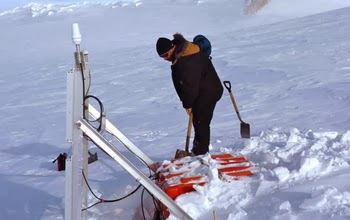The West Antarctic Ice sheet is buttressed by huge ice shelves at it's edges which hold back the ice streams. Warming Southern ocean currents are melting ice shelves, causing them to retreat, allowing faster discharge of ice flows from the interior. Much of the ice sheet is grounded on a sub-glacial basin below sea level, so as the ice shelf grounding line retreats, more warm water can interact with the ice to speed the discharge and collapse of the ice sheet. Volcanic activity adds further potential instability to this process.
The scientists from Washington University in St Louis discovered the seismic bursts originate at about 25 to 40 kilometre depth and are typical of deep long period earthquakes (DLPs) generated by magma moving about within the crust.
The current earthquake activity is located about 55-60 kilometers (34-37 miles) south of Mt. Sidley, where current volcanic activity would be predicted to occur based on the geographic locations and the ages of the lava of the known volcanoes in the Executive Committee Range. The volcanoes of the Executive Committee Range in Marie Byrd Land were thought to be dormant.
According to the researchers the seismic swarms were located near a subglacial high-point of elevation and magnetic anomalies which are both indicative of a volcano.
"This [study] is saying that we have seismicity, which means [this system] is active right now," said Amanda Lough, a doctoral candidate at Washington University in St. Louis and lead author of the study. "This is saying that the magmatic chamber is still alive; that there is magma that is moving around in the crust."
Radar mapping has detected an ash layer in the ice above the area of seismicity, which was initially thought by Lough and her colleagues to originate from the volcano detected in the study. Further investigation of prevailing winds indicated it was probably from Mt. Waesche nearby about 8,000 years ago. Mt Waesche was previously thought to be last active 100,000 years ago.

Caption: Melt water from the new volcano will drain into the MacAyeal Ice Stream, labeled above as ice stream E, its original designation. This radar image of West Antarctica (see box on the inset at bottom right for location) has been color-coded to indicate the speed at which the ice is moving. Red marks the fast-moving centers of the ice streams and black lines outline each stream’s catchment area. By greasing the skids with water, the new volcano might increase the rate of ice loss from the MacAyeal Ice Stream. Image: NASA/Earth Observatory
Doug Wiens, who is Professor of earth and planetary sciences in Arts & Sciences at Washington University in St. Louis and one of the project’s principal investigators, said “Most mountains in Antarctica are not volcanic, but most in this area are. Is it because East and West Antarctica are slowly rifting apart? We don’t know exactly. But we think there is probably a hot spot in the mantle here producing magma far beneath the surface.”
“People aren’t really sure what causes Deep Long Period earthquakes,” Lough said. “It seems to vary by volcanic complex, but most people think it’s the movement of magma and other fluids that leads to pressure-induced vibrations in cracks within volcanic and hydrothermal systems.”
Asked if the volcano is likely to erupt, Lough said, “Definitely. In fact, because the radar shows a mountain beneath the ice, I think it has erupted in the past, before the rumblings we recorded.”
If there were an eruption under the ice, we may not see visual signs unless it was extremely powerful, enough to break through the 1 to 1.5 kilometre thick ice sheet. However, a smaller eruption could cause additional melting of the bottom of the ice sheet, thereby increasing the bed lubrication and hastening ice loss from WAIS.
The water would rush beneath the ice toward the sea and feed into the hydrological catchment of the MacAyeal Ice Stream, one of several major ice streams draining ice from Marie Byrd Land into the Ross Ice Shelf. This would speed up the ice stream discharge into the Ross Sea.
The study published in Nature Geoscience by Lough et al - Seismic detection of an active subglacial magmatic complex in Marie Byrd Land, Antarctica (abstract) - concludes:
"...these observations provide strong evidence for ongoing magmatic activity and demonstrate that volcanism continues to migrate southwards along the Executive Committee Range. Eruptions at this site are unlikely to penetrate the 1.2 to 2-km-thick overlying ice, but would generate large volumes of melt water that could significantly affect ice stream flow."
This adds another factor to the stability of the West Antarctic Ice sheet.
Sources:
- NSF media release, 20 November 2013 - Early-career investigator discovers current volcanic activity under West Antarctica
- Lough et al - Seismic detection of an active subglacial magmatic complex in Marie Byrd Land, Antarctica (abstract) Nature Geoscience (2013) doi:10.1038/ngeo1992
- University of Washington at St Louis, media release, 17 November 2013 -Volcano discovered smoldering under a kilometer of ice in West Antarctica
- Lead Image - Digging out a seismographic instrument in Antarctica. Credit: Douglas Wiens, Washington University in St. Louis via NSF.


No comments:
Post a Comment